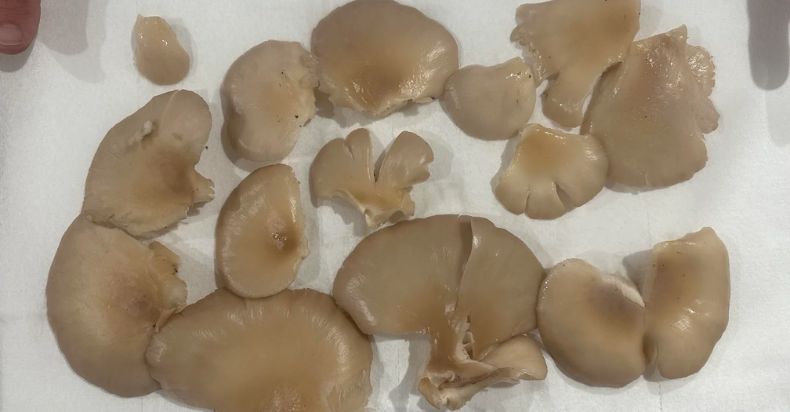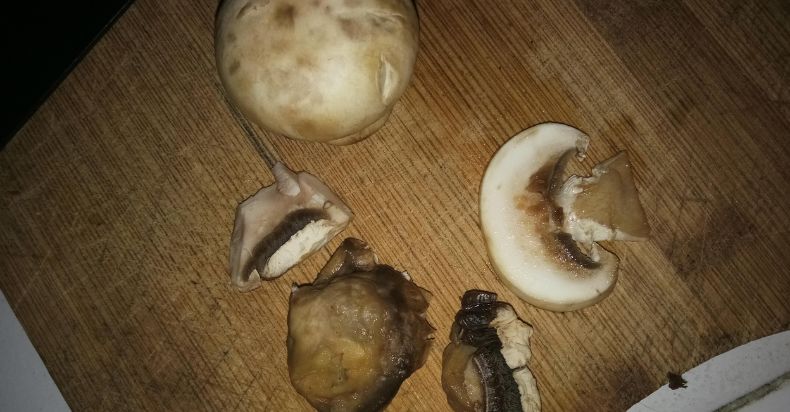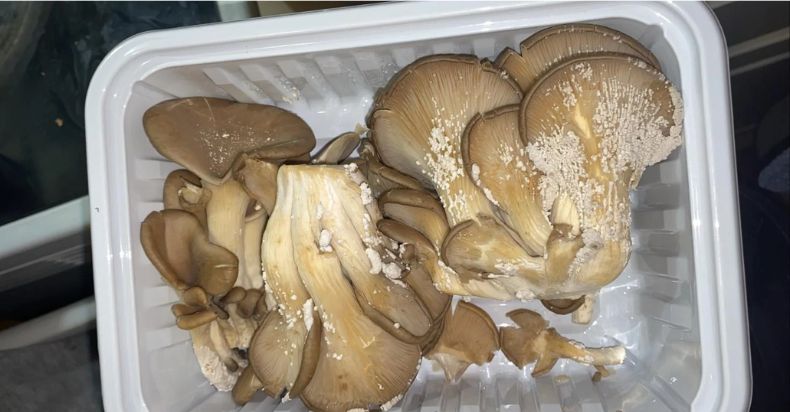Hey there, mushroom muncher! I bet you’re here because you’ve got a batch of mushrooms sitting in your fridge, and you’ve noticed some brown spots on them, huh? Now you’re wondering, “Is it safe to eat mushrooms with brown spots?” Well, you’ve come to the right place!
Mushrooms, those delicious, earthy morsels that make our pizzas, pastas, and salads so much more exciting, can sometimes be a bit of a mystery. One day, they’re all white and pristine, and the next, they’ve got these weird brown spots. It’s like they’re teenagers with a bad case of acne.
But before you toss them out, let’s dive into the world of mushrooms and find out what those brown spots really mean. Are they a sign of danger, or just a harmless blemish? Let’s find out!
In the next section, we’ll unravel the mystery behind these brown spots. So, keep reading, unless you want to live in the dark forever about your fungi friends. Got it? Good. Let’s go!
The Mushroom Mystery: What Are Brown Spots?

Ok… sooo, you’ve noticed some brown spots on your mushrooms and you’re wondering, “What the heck are these?” Well, let me enlighten you, my curious friend.
Brown spots on mushrooms are pretty common, and they can appear for a variety of reasons. Sometimes, they’re just a result of the mushroom’s natural aging process. You know, like wrinkles on humans? As mushrooms age, they can develop spots, change color, or even get a bit slimy. It’s all part of their charm!
Other times, these spots can be a sign of bruising. Mushrooms are delicate creatures. If they get bumped or handled roughly, they can bruise, just like you or I. These bruises can appear as brown spots on their surface.
But here’s the kicker: brown spots can also be a sign of decay. If your mushrooms have been sitting around for too long, they might start to decompose, and this can show up as brown spots.
So, now that you know what these brown spots are, the next question is: are they safe to eat? Well, hold your horses, we’re getting to that. But first, let’s delve a little deeper into why mushrooms get brown spots in the first place. Stay tuned!
Why Do Mushrooms Get Brown Spots?
Alright, let’s get down to the nitty-gritty. Why do mushrooms get brown spots? It’s not like they’re out in the sun getting freckles, right?
Well, as I mentioned earlier, one reason is simply aging. Mushrooms, like all living things, go through a process of aging. As they get older, their color can change, and they can develop spots. It’s like mushroom puberty, but without the awkwardness and mood swings.
Another reason is bruising. Mushrooms are delicate, and they bruise easily. This can happen during harvesting, transportation, or even when you’re rummaging through your fridge looking for that leftover pizza. These bruises can show up as brown spots.
Finally, and this is the one you’ve got to watch out for, brown spots can be a sign of decay. If your mushrooms have been sitting around for too long, they can start to decompose. This is a natural process, but it’s not one you want happening in your fridge!
So, there you have it. The mystery of the brown spots, solved! But I know what you’re thinking: “Great, but can I eat them or not?” Patience, my friend. We’re getting to that. Keep reading!
To Eat or Not to Eat: The Safety of Brown-Spotted Mushrooms

Alright, we’ve kept you in suspense long enough. It’s time to answer the million-dollar question: Is it safe to eat mushrooms with brown spots?
Well, like many things in life, the answer is: it depends.
If the brown spots are due to aging or bruising, then yes, it's generally safe to eat these mushrooms. They might not taste as fresh, and their texture might be a bit off, but they won't harm you. It's kind of like eating a bruised apple. Not the best culinary experience, but not a trip to the emergency room either.
However, if the brown spots are a sign of decay, then it’s a different story. Decaying mushrooms can develop harmful bacteria and molds that can make you sick. And trust me, food poisoning is not a fun ride.[1]
So, how can you tell the difference? Well, there are a few signs to look out for. If the mushrooms are slimy, have a foul smell, or are discolored in other ways (like turning dark or black), then it’s best to toss them out. Better safe than sorry, right?
But don’t worry, there are ways to safely consume mushrooms, even with brown spots. Let’s dive into that next!
READ : 9 Surprising Reasons Why Your Mango Is Brown Inside
The Risks of Eating Brown-Spotted Mushrooms

Before we get into the safe ways to consume mushrooms, let’s take a moment to understand the risks associated with eating brown-spotted mushrooms.
As we’ve discussed, brown spots can be a sign of decay. And decayed mushrooms? They’re not your friends. They can harbor harmful bacteria and molds that can lead to food poisoning. Symptoms can range from mild (think stomach cramps and diarrhea) to severe (like vomiting and fever). In rare cases, it can even be life-threatening.[source]
And here’s something else to consider: some mushrooms can develop a toxin called hydrazine as they decay. This toxin can cause symptoms like dizziness, nausea, and in severe cases, even seizures.
So, while a few brown spots due to aging or bruising are generally safe, if there’s any sign of decay, it’s best to play it safe and throw those mushrooms away.
But don’t let this scare you away from mushrooms altogether! There are plenty of ways to enjoy these tasty fungi safely. Let’s explore that next.
READ: Is It Safe To Eat Broccoli With Brown Spots?
The Safe Way to Consume Mushrooms:
So, you’ve got some brown-spotted mushrooms and you’re not sure what to do with them. Don’t worry, I’ve got you covered. Here are some tips to safely consume mushrooms, even with brown spots:
- Check for Other Signs of Decay: Brown spots alone don’t necessarily mean your mushrooms are off. Check for other signs of decay like a slimy texture, a foul smell, or other discoloration. If you spot any of these, it’s time to say goodbye to those mushrooms.
- Cook Them Thoroughly: Cooking can kill most bacteria and molds that might be present on your mushrooms. So, if you’re going to eat brown-spotted mushrooms, make sure to cook them thoroughly.
- Store Them Properly: Mushrooms like cool, dry places. Store them in the fridge in a paper bag, which can absorb excess moisture and keep them fresh for longer.
- When in Doubt, Throw it Out: If you’re not sure whether your mushrooms are safe to eat, it’s best to err on the side of caution and throw them out. It’s not worth risking your health for the sake of a few mushrooms.
Remember, while mushrooms are a delicious and nutritious addition to your meals, it’s important to consume them safely. So, the next time you see brown spots on your mushrooms, don’t panic. Just follow these tips and you’ll be fine.
And that, my friend, is the lowdown on eating mushrooms with brown spots. But wait, there’s more! Stick around for the conclusion and some FAQs.
Key Takaways:
Well, there you have it! We’ve journeyed through the world of mushrooms, unraveled the mystery of brown spots, and learned how to safely consume these tasty fungi.
So, is it safe to eat mushrooms with brown spots? The answer is a resounding “maybe.” If those spots are due to aging or bruising, then go ahead and enjoy your mushroom feast. But if there’s any sign of decay, it’s best to toss them out. Remember, when it comes to food safety, it’s always better to be safe than sorry.
But don’t let this deter you from enjoying mushrooms. They’re a versatile and delicious ingredient that can add a lot of flavor and nutrition to your meals. Just remember to store them properly, check for signs of decay, and cook them thoroughly.
And that’s it! You’re now a certified mushroom expert. So, the next time you see brown spots on your mushrooms, you’ll know exactly what to do. Now, go forth and enjoy your fungi feast!
But wait, we’re not done yet! We’ve got some FAQs coming up that you might find helpful. So, stick around!
FAQs:
Can you eat mushrooms with brown spots?
Yes and no. If the brown spots are due to aging or bruising, then it’s generally safe to eat these mushrooms. However, if the brown spots are a sign of decay, it’s best to throw them out as they can harbor harmful bacteria and molds.
What do brown spots on mushrooms mean?
Brown spots on mushrooms can be a result of the natural aging process, bruising, or decay. As mushrooms age or get bruised, they can develop brown spots. If they’ve been sitting around for too long, they can start to decompose, which can also show up as brown spots.
How can I tell if my mushrooms have gone bad?
Apart from brown spots, other signs of decay in mushrooms include a slimy texture, a foul smell, or other discoloration like turning dark or black. If you notice any of these signs, it’s best to throw the mushrooms out.
How should I store my mushrooms to keep them fresh?
Mushrooms like cool, dry places. Store them in the fridge in a paper bag, which can absorb excess moisture and keep them fresh for longer.
Can I get sick from eating old mushrooms?
Yes, eating decayed mushrooms can lead to food poisoning, with symptoms ranging from mild (like stomach cramps and diarrhea) to severe (like vomiting and fever). In rare cases, it can even be life-threatening.
So, it’s always best to consume mushrooms when they’re fresh and to throw them out if there’s any sign of decay.
